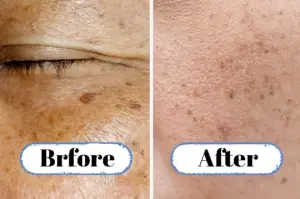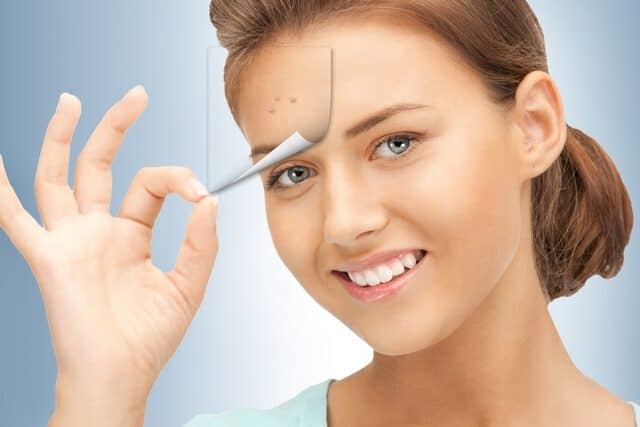To treat melasma, which is characterized by dark spots on the skin, lightening creams such as hydroquinone or tretinoin can be used, or cosmetic treatments such as laser, chemical peeling, or micro-needling can be done, all of them guided by a dermatologist.
Melasma is more common in areas exposed to the sun such as the face, so it is very important to use sunscreen so that the lightening is satisfactory and so that no new lesions appear. In addition, melasma can have various causes, such as hormonal changes during pregnancy, use of contraceptives, use of some medications, or aging, for example.
Melasma has a cure, and the best treatment varies according to the type, place of the body affected, and the depth of the stain, which can be superficial or epidermal, deep or dermal and mixed, therefore, it is important to talk with the dermatologist to decide what is the ideal treatment:
1. Lightening creams
The creams that lighten the spots are very effective, despite being part of long-term treatment, they have long-lasting results, and can be used anywhere on the body:
- Hydroquinone contains a lightening active ingredient and should be used 1 to 2 times a day, but for a limited time, due to its irritating effects on the skin, such as flaking and itching;
- Retinoids, such as Tretinoin, Adapalene, and Tazarotene used in cream or gel form, are helpful in reducing darkening of the skin;
- Topical corticosteroid, in ointments, can be used for a short period of time to decrease the inflammation of the skin that can cause spots;
- Azelaic acid also has an effect on controlling the amount of melanin and darkening of the skin;
- Other acids such as kojic, glycolic, and salicylic acids are present in cosmetic treatments and are most effective when they are associated with other acids to help lighten and renew the skin.
The treatment time varies according to the product used and the depth of the affected skin, and the results can begin to be seen after 2 to 4 weeks of treatment, which can last up to about 6 months.

2. Aesthetic treatments
These types of treatment must be carried out by qualified professionals, and are guided by the dermatologist, since they promote the elimination of the superficial layer of the skin, and provide faster results:
- A chemical peel is made with acids at concentrations stronger than those used in creams, to remove a layer of the skin. It can be mild for superficial melasma or more intense for deep melasma.
- Microdermabrasion, known as facial renewal, is a professional exfoliation technique that removes the superficial layers of the skin for a renewed appearance;
- Microneedling is a technique that pierces the skin with microneedles to stimulate collagen production and blood circulation in the skin, which can be useful to reduce some spots on the skin, in addition to reducing wrinkles and sagging of the face;
- Intense pulsed light is not an initial option, but it is used in some cases that do not improve with other treatments and can even worsen the spots on the skin if used incorrectly.
Generally, several sessions are necessary to obtain the desired result, which varies according to the intensity and depth of the melasma.

3. Laser treatment
The laser is a good option for the treatment of spots since it releases a heatwave on the skin, which destroys the melanin pigment, and is indicated in cases of deep melasma or that did not improve with treatment with creams or cosmetics.
Weekly sessions are held and the amount also varies depending on the severity and depth of the stain. In addition, this treatment should always be guided by a trained dermatologist, due to the risk of skin burns.
4. Nutricosmetics
The use of some supplements can be useful during the treatment of melasma, to replace some deficiencies of vitamins and minerals important for the health of the skin that may be lacking in the diet.
Some options are tranexamic acid, which inhibits substances that cause darkening of the skin, in addition to antioxidants such as vitamin C, lutein, collagen, carotenoids, flavonoids, selenium, and minerals, which help in the recovery of the skin, in addition to preventing wrinkles and sagging.
5. Sunscreen
Sunscreen is the most important treatment for melasma, as no other will be effective without protecting the skin from the sun’s rays. Sunscreen should be used with a minimum factor of 15 SPF, every day, even if the day is cloudy or the person is indoors.
It is also important to avoid exposure to the sun when treating the spots, and if you are in sunny environments, it is important to reapply sunscreen every 2 hours.
How to treat melasma in pregnancy
To treat melasma during pregnancy, also known as chloasma, you should use sunscreen and natural moisturizers daily. Preferably the products should be hypoallergenic and oil-free, so that they do not leave the skin greasy and thus avoid the appearance of pimples, also common in pregnancy.
The use of lightening creams or aesthetic treatments with chemical, acid, or laser products is contraindicated in pregnancy. In very necessary cases, azelaic acid and salicylic acid in low doses do not present risk in this period, but preferably, any treatment should be postponed until the end of pregnancy and lactation.
In addition, due to the hormonal alterations of pregnancy, the treatment of spots on the skin is difficult, and also, it is very likely that the spots on the skin will improve naturally at the end of the pregnancy.

